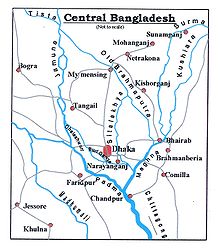Shitalakshya River
| Shitalakshya River | |
|---|---|
 Shitalakhya River near Narayanganj | |
 | |
| Location | |
| Country | Bangladesh |
| City | Narayanganj |
| Physical characteristics | |
| Length | 110 km (68 mi) |
| Discharge | |
| • location | Meghna River |
Shitalakshya River (Bengali: শীতলক্ষ্যা নদী pronounced: Shitalokkha Nodi) (also known as Lakhya River) is a distributary of the Brahmaputra. In its initial stages, it flows in a southwest direction and then east of the city of Narayanganj in central Bangladesh until it merges with the Dhaleswari near Kalagachhiya. A portion of its upper course is known as Banar River or Banor River. The river is about 110 kilometres (68 mi) long and at it widest, near Narayanganj, it is 300 metres (980 ft) across. Its flow, measured at Demra, has reached 74 cubic metres per second (2,600 cu ft/s).[1] It remains navigable year round.[1] The river flows through Gazipur district forming its border with Narsingdi for some distance and then through Narayanganj District.
The river's maximum depth is 21 metres (70 ft) and average depth is 10 metres (33 ft).
Change in course of rivers[]
The Shitalakhya is a branch of the Brahmaputra which has changed its course at least twice in the Bangladesh region in the fairly recent past, indirectly affecting the flow of water in the Shitalakhya. In the 21st century, the main flow of the Brahmaputra waters is through the Jamuna channel. Earlier, after tracing a curve round the Garo Hills on the west, it took a sharp turn in the south-east direction near Dewanganj, and then passing by Jamalpur and Mymensingh, threw off the Shitalakhya branch and flowed through the eastern part of Dhaka district and fell into the Dhaleshwari. The Shitalakhya ran almost parallel to the Brahmaputra and after passing by Narayanganj joined the Dhaleswari. The course of the Brahmaputra through Dhaka district was deserted by the 18th century, when it flowed further east and joined the Meghna near Bhairab. Towards the end of the 18th century the Jamuna channel increased its importance and around 1850 it became the main channel of the Brahmaputra.[2]
In Van den Brouck's map, the river is marked as Lecki, flowing west of Barrempooter (Brahmaputra). In Van den Brouck's time (1660), it was a large and swift flowing river. It was so till the early 19th century.[3] There, however, are some reservations about the accuracy of Van den Brouck's map.

Historical importance[]
Sonargaon, a former capital of the region, stood on the banks of the Shitalakhhya. A fort was built by Isa Khan, a former ruler of the area, on its banks. It is believed that it was connected with Lalbagh Fort in Dhaka through a tunnel. Sonakanda Fort, also on the river, was built to counter Magh and Portuguese pirates. There are several historical mosques on its banks – Bandarshahi mosque (built in 1481 by Baba Saleh), Kadam Rasul mosque (containing the footprints of Muhammad), Mariamer masjid (built by Shaista Khan) etc.[4]
Economic importance[]
The Shitalakshya River was once an important center for the muslin industry.[1] Even today, there are centres of artistic weaving on its banks. There also are a number of industrial units on its banks, including the Adamjee Jute Mills. Thermal power houses are located along the river at Palash (north of Ghorashal) and at Siddhirganj.[1] Industrial affluent dumped into the river resulting in high levels of pollution is a cause for concern.[5]

There is a river port in Narayanganj.[1] Numerous launches move out along the river to different parts of Bangladesh. The government has approved construction of a container terminal on the river Shitalakhya with foreign investment.[6]
References[]
- ^ a b c d e Md Mahbub Murshed (2012). "Shitalakshya River". In Sirajul Islam and Ahmed A. Jamal (ed.). Banglapedia: National Encyclopedia of Bangladesh (Second ed.). Asiatic Society of Bangladesh.
- ^ Majumdar, Dr. R.C., History of Ancient Bengal, First published 1971, Reprint 2005, pp. 3-4, Tulshi Prakashani, Kolkata, ISBN 81-89118-01-3.
- ^ Roy, Niharranjan, Bangalir Itihas, Adi Parba, (in Bengali), first published 1972, reprint 2005, p. 86, Dey’s Publishing, 13 Bankim Chatterjee Street, Kolkata, ISBN 81-7079-270-3
- ^ Khokon, Leaquat Hossain, 64 Jela Bhraman, 2007, pp.14-15, Anindya Prokash, Dhaka, ISBN 984-8740-19-8
- ^ Alam, Mohammad Naushad; Elahi, Fazle; Didar-Ul-Alam, Md. "Risk and Water Quality Assessment overview of River Sitalakhya in Bangladesh". Academic Open Internet Journal. Technical College, Bourgas. ISSN 1311-4360. Retrieved 2007-11-22.
- ^ "Govt okays container terminal on Shitalakhya". The Independent. Dhaka. UNB. Archived from the original on 2007-08-14. Retrieved 2007-11-17.
Coordinates: 23°34′14″N 90°32′02″E / 23.57056°N 90.53389°E
- Rivers of Bangladesh
- Distributaries
- Rivers of Dhaka Division
